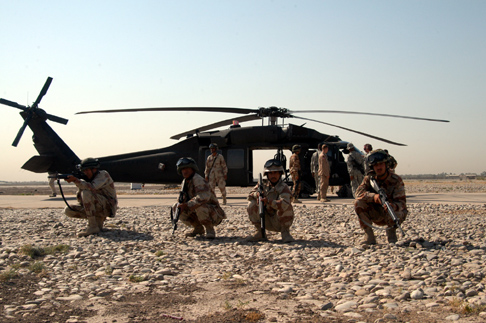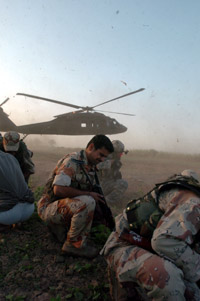|
|
|
Iraqi soldiers from 4th Brigade, 6th Iraqi Army Division, practice air assault operations on Camp Striker July 30. Air assault is taught at the Commando Course, an advanced infantry course designed by 2nd Battalion, 15th Field Artillery Regiment, 2nd Brigade Combat Team, 10th Mountain Division (Light Infantry) from Fort Drum, N.Y. (U.S. Army photo by Major Web Wright, 2nd BCT Public Affairs, 10th Mtn. Div. (LI)). [The 4-6 Brigade has since expanded and become the 17th Division.] |
The Iraqi Government has been ordering substantial numbers of weapons this year. These orders, combined with known training plans, and existing force structure, provide insight into the eventual planned force structure of elements of the Iraqi Security Forces. The Air Force has been previously addressed. The focus of this article is on the announced arms purchases and what they indicate for developments in the Iraqi Army’s light divisions.
The three stages of upgrading the Iraqi Security Forces are organized into five year plans. The first stage started with the establishment of the first elected Iraqi Government in 2006 and it lasts until 2011. Stage one is intended to build a basic force. The Iraqi Army is apparently planned to be 20 or 21 divisions organized into four corps by the end of this stage.
The second stage is to build the forces up in capabilities including independent armored, mechanized, airmobile, naval, and air forces, thus converting the existing basic force into a heavier, more capable force. Stage two lasts from 2011 to 2015. The arms purchases for the beginning of stage two have been and are being announced. The third stage is to complete the training and improvements.
Stage three should be thought of as the insurance period for any slippage in training and developing the ISF, such as that caused by a reduced budget due to lower oil prices.
While the Iraqi Army is currently almost all light infantry, most of the force shows signs of evolving into motorized, mechanized, or armored units. The mortar purchases, transfers of Kurdish forces, and training indicate that the Iraqi army is to have only eight light divisions when completed.
Four of those divisions are to be mountain divisions transferred from the Kurdish Regional Government. Two (15th and 16th) have already transferred but have not been fully integrated into the Iraqi Army command structure. The other four divisions are to be airmobile forces. One located in each of the four corps sectors. These divisions are:
• The 8th Commando Division in the future southern Corps
• The 17th Commando Division in the future central Corps
• Probably the 4th Division to the Quick Reaction Force Corps (Mostly airmobile experienced.)
• Probably the 2nd Division to the future Northern Corps (Planned to be trained in airmobile.)
|
|
|
Iraqi army soldiers with 2/25/17th IA Division, prepare to load onto UH-60 Black Hawk helicopters upon completion of Operation Eagle North Point, a combined air assault in Abu Osage, Oct. 8, 2008. |
The mortar purchase indicates that at least seven, probably eight divisions are to be infantry. Those types of mortars are not the self-propelled versions normally used for heavy or light armored formations. Also, mountain and airmobile infantry tend to be lighter than conventional infantry in their mortar complements for mobility reasons. This is why there is a varience in the estimate of how many divisions the mortar purchase will equip.
However, four of the existing infantry divisions have already been identified as commando or mountain, two more infantry divisions are planned to transfer from the Kurdish Regional Government and will also be mountain, and there are two more divisons that have been identified as probably future airmobile, airborne, or commando. This means a total of eight infantry divisions are probably planned and that all of them will be the lighter airmobile or mountain configurations.
Two of the mountain divisions (15th and 16th Mountain) and two of the airmobile divisions (8th and 17th Commando) are already confirmed in existence. The conversions and transfers of the other four divisions appear to be works in progress or planned. While the mountain divisions will probably be retained in the north and QRF Corps, the airmobile divisions are positioned to provide one each to all four corps.
The Iraqi Air Force buys have already been addressed. The impact and relationship to the Iraqi Army was not. The significant numbers of armed reconnaissance, helicopter armed reconnaissance, attack helicopters, and transport helicopters indicate the establishment of dedicated aviation brigades to support airmobile forces.
These aviation brigades could be assigned to the four divisions that are to be airmobile. However, these aviation brigades are more likely to be assigned to the four corps and to the Iraqi Ground Forces Command (IGFC) to be employed as needed. Each of the corps would get the support of one squadron each of armed reconnaissance, helicopter armed, reconnaissance, attack helicopters, and transport helicopters.
The fifth aviation brigade supporting the IGFC would not have the armed reconnaissance squadron, but would have two transport helicopter squadrons. This would provide each corps the ability to move one airmobile battalion per lift or one to two brigades per day while providing them air support. If the IGFC augments a corps with its aviation brigade, then the fire support is doubled and the transport tripled, allowing a brigade to be moved per lift or one division per day to be shifted by helicopter up to 100 miles. The Iraqi Army is also planning to have one battalion per brigade airmobile trained in addition to the four planned airmobile divisions.
The Iraqi Army will probably have these light divisions operational by the end of 2011. However, the airmobile divisions require the Iraqi Air Force squadrons planned to be built during stage two (2011 to 2015), in order to be more than high-end infantry. There are 16 to 20 of the planned 38 Iraqi Air Force squadrons intended for direct Iraqi Army support. Seven of those squadrons (transport helicopters) would be required for the airmobile forces to be independently airmobile (minus air fire-support). To employ them as airmobile prior to those squadrons becoming operational, will require US Aviation support.
This is the second in a series of articles on Iraqi Security Force components. The first was “Iraq announces plan to expand the Air Force“.










1 Comment
The Thunder Run has linked to this post in the blog post From the Front: 11/20/2008 News and Personal dispatches from the front and the home front.